Nissan Pathfinder: System Description - System ++
System Description
SYSTEM DIAGRAM — WITHOUT BOSE AUDIO SYSTEM
Except For Mexico 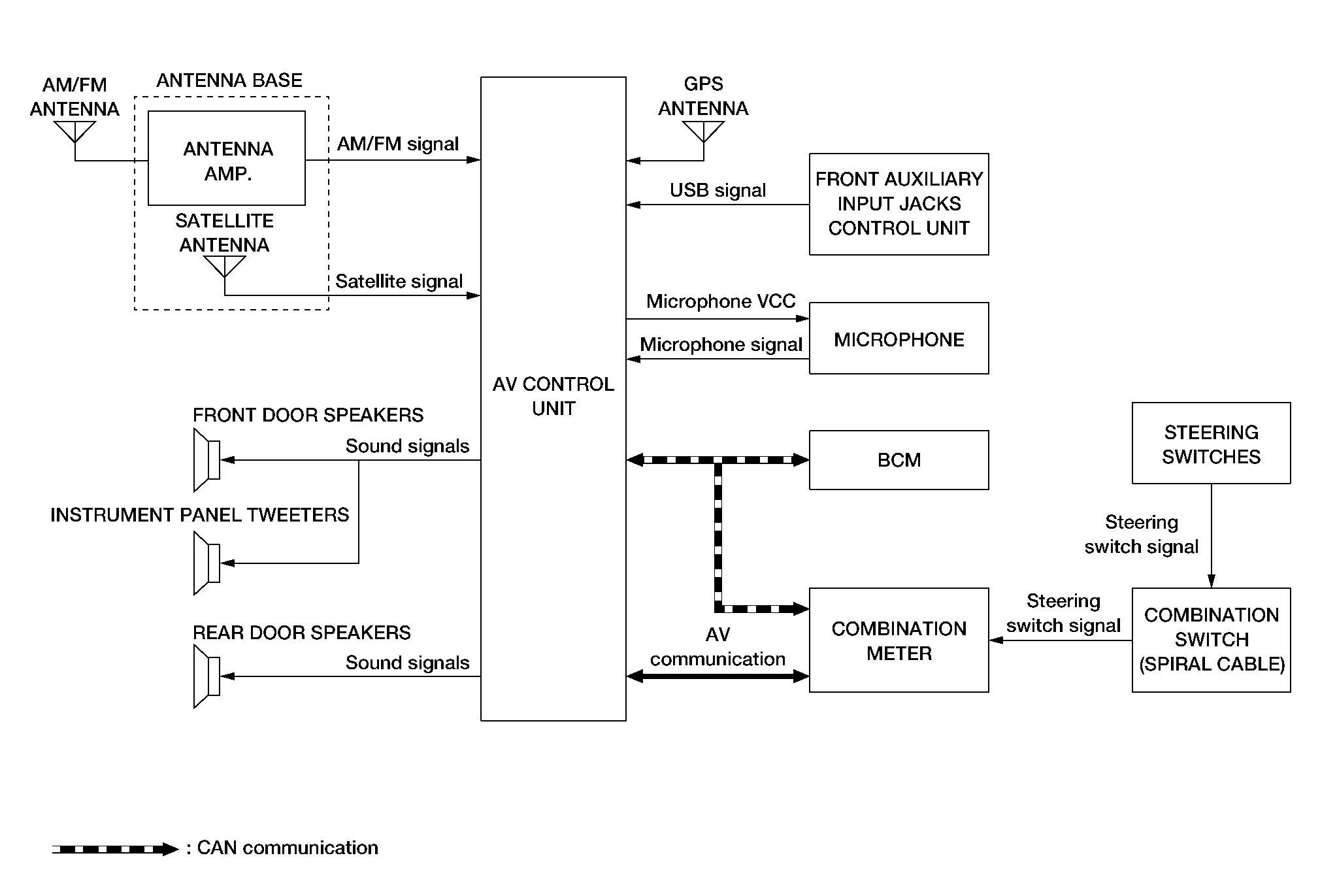
For Mexico 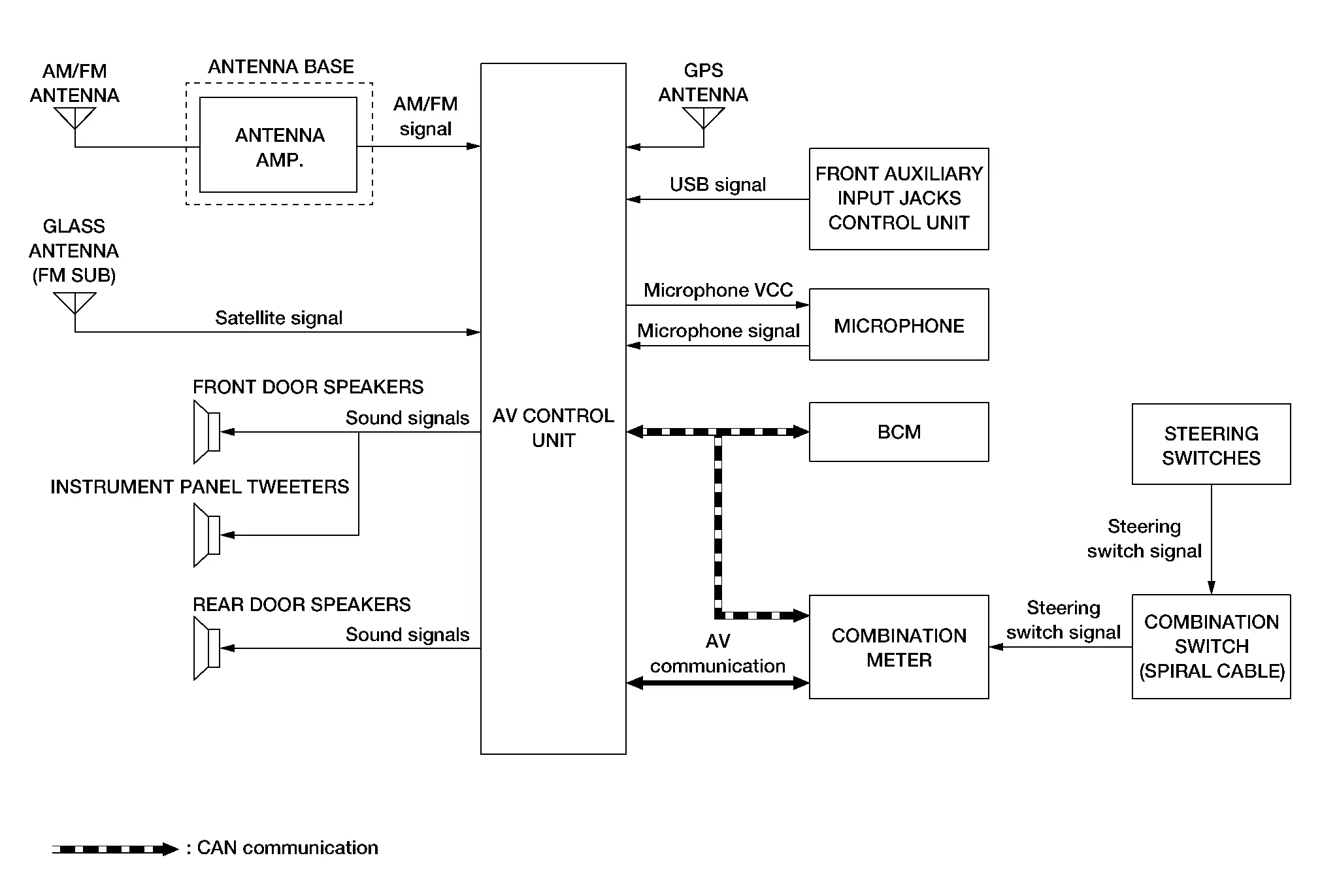
AV Control Unit Input Signal (AV Communication)
| Transmit unit | Signal name |
|---|---|
| Combination meter | Steering switch signal |
AV Control Unit Input Signal (CAN Communication)
| Transmit unit | Signal name |
|---|---|
| BCM | Position light request signal |
| Combination meter |
|
SYSTEM DIAGRAM — WITH BOSE AUDIO SYSTEM
Except For Mexico 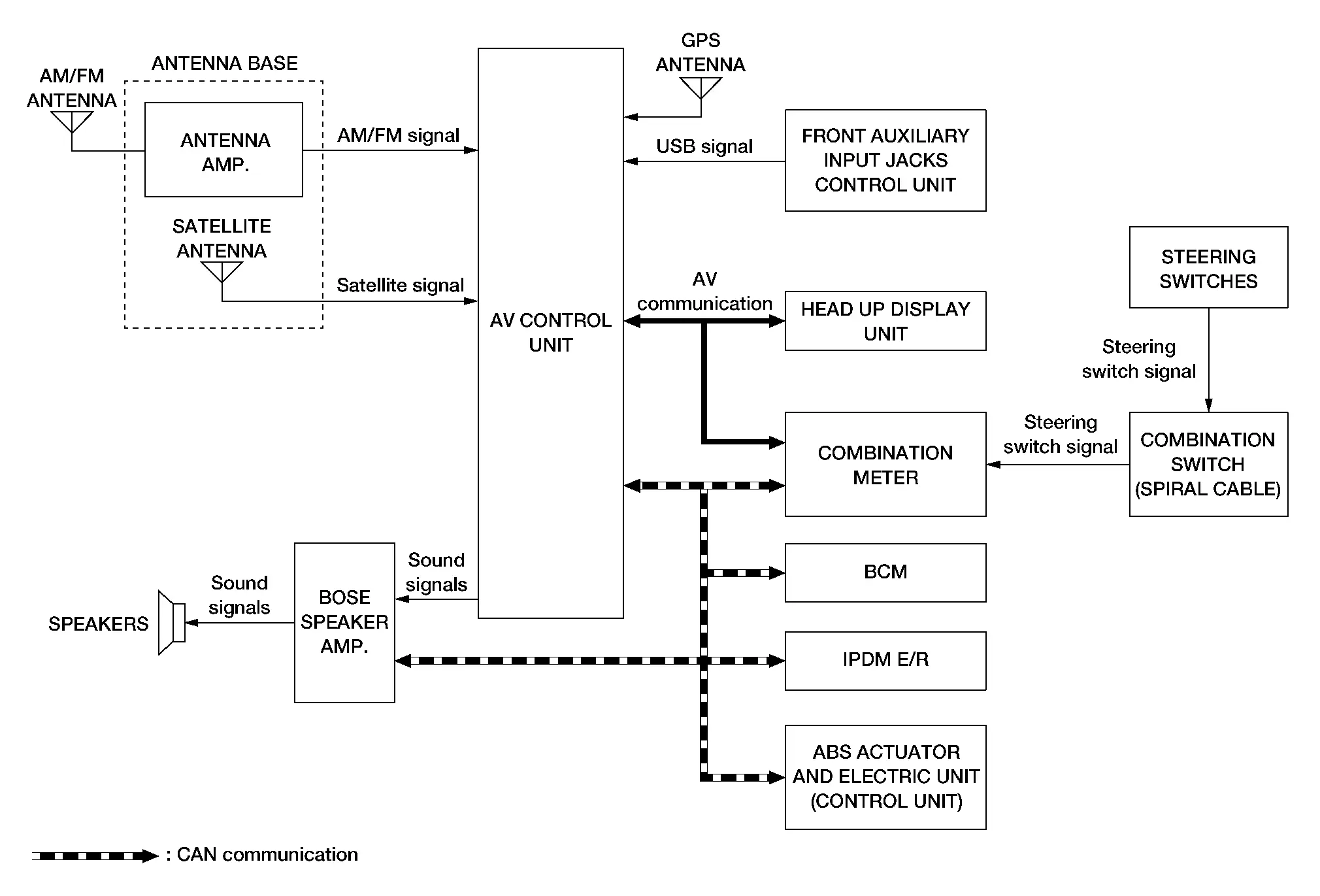
For Mexico 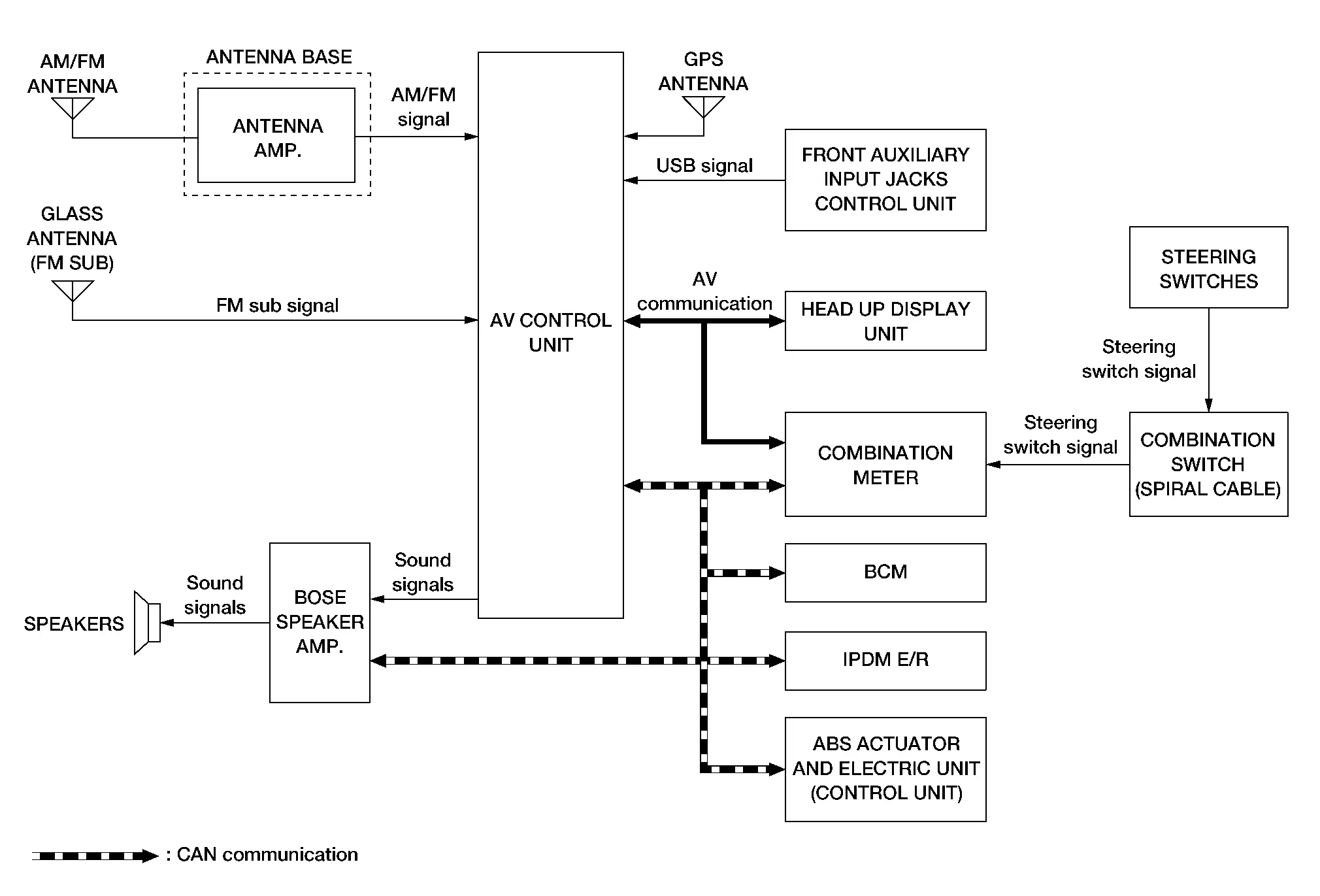
AV Control Unit Input Signal (AV Communication)
| Transmit unit | Signal name |
|---|---|
| Combination meter | Steering switch signal |
AV Control Unit Input Signal (CAN Communication)
| Transmit unit | Signal name |
|---|---|
| BCM | Position light request signal |
| Combination meter |
|
Bose Speaker Amp. Input Signal (CAN Communication)
| Transmit unit | Signal name |
|---|---|
| ABS actuator and electric unit (control unit) | Odometer signal |
| BCM | Sleep wake up signal |
| IPDM E/R | Battery voltage signal |
AUDIO SYSTEM
Without Bose Audio System
Except For Mexico
The audio system consists of the following components:
-
AV control unit
-
Instrument panel tweeters
-
Front door speakers
-
Rear door speakers
-
Microphone
-
Front auxiliary input jacks
-
Steering switches
-
Combination meter
-
Combination switch (spiral cable)
-
GPS antenna
-
Antenna base (satellite antenna and antenna amp.)
When the audio system is on:
-
AM/FM signals received by the antenna base are amplified by the antenna amp. and sent to the AV control unit. The AV control unit sends the audio signals to the speakers.
-
Satellite signals received by the antenna base (satellite antenna) are sent to the AV control unit. The AV control unit sends the audio signals to the speakers.
For Mexico
The audio system consists of the following components:
-
AV control unit
-
Instrument panel tweeters
-
Front door speakers
-
Rear door speakers
-
Microphone
-
Front auxiliary input jacks
-
Steering switches
-
Combination meter
-
Combination switch (spiral cable)
-
GPS antenna
-
Antenna base (antenna amp.)
-
Glass antenna (FM sub)
When the audio system is on:
-
AM/FM signals received by the antenna base are amplified by the antenna amp. and sent to the AV control unit. The AV control unit sends the audio signals to the speakers.
-
The glass antenna (FM sub) receives radio signals and outputs them to the AV control unit. The AV control unit sends the audio signals to the speakers.
Refer to Owner's Manual for audio system operating instructions.
With Bose Audio System
Except For Mexico
The audio system consists of the following components:
-
AV control unit
-
Bose speaker amp.
-
Instrument panel tweeters
-
Center speaker
-
Front tweeters
-
Front door speakers
-
Rear door speakers
-
Rear side speakers
-
Subwoofer
-
Front auxiliary input jacks
-
Steering switches
-
Combination meter
-
Combination switch (spiral cable)
-
GPS antenna
-
Antenna base (satellite antenna and antenna amp.)
When the audio system is on:
-
AM/FM signals received by the antenna base are amplified by the antenna amp. and sent to the AV control unit. The AV control unit sends the audio signals to the Bose speaker amp. The Bose speaker amp. then sends the audio signals to the speakers.
-
Satellite signals received by the antenna base (satellite antenna) are sent to the AV control unit. The AV control unit sends the audio signals to the Bose speaker amp. The Bose speaker amp. then sends the audio signals to the speakers.
For Mexico
The audio system consists of the following components:
-
AV control unit
-
Bose speaker amp.
-
Instrument panel tweeters
-
Center speaker
-
Front tweeters
-
Front door speakers
-
Rear door speakers
-
Rear side speakers
-
Subwoofer
-
Front auxiliary input jacks
-
Steering switches
-
Combination meter
-
Combination switch (spiral cable)
-
GPS antenna
-
Antenna base (antenna amp.)
-
Glass antenna (FM sub)
When the audio system is on:
-
AM/FM signals received by the antenna base are amplified by the antenna amp. and sent to the AV control unit. The AV control unit sends the audio signals to the Bose speaker amp. The Bose speaker amp. then sends the audio signals to the speakers.
-
The glass antenna (FM sub) receives radio signals and outputs them to the AV control unit. The AV control unit sends the audio signals to the Bose speaker amp. The Bose speaker amp. then sends the audio signals to the speakers.
Refer to Owner's Manual for audio system operating instructions.
NAVIGATION SYSTEM
Description
-
The navigation system can be operated by control panel of the AV control unit and display (touch panel) of the AV control unit.
-
Guide sound during the operation of the navigation system is output from AV control unit to front tweeters.
-
AV control unit calculates the Nissan Pathfinder vehicle location based on the signals from GYRO (angle speed sensor), vehicle sensor, and GPS satellite, as well as the map data. The Nissan Pathfinder vehicle location is displayed on the AV control unit.
POSITION DETECTION PRINCIPLE
The navigation system periodically calculates the vehicle's current position according to the following three signals:
-
Travel distance of the vehicle as determined by the vehicle speed sensor
-
Turning angle of the Nissan Pathfinder vehicle as determined by the gyroscope (angular velocity sensor)
-
Direction of vehicle travel as determined by the GPS antenna (GPS information)
The current position of the vehicle is then identified by comparing the calculated vehicle position with map data (map-matching), and indicated on the screen as a Nissan Pathfinder vehicle mark. More accurate data is judged and used by comparing vehicle position detection results found by the GPS with the result by map-matching.
The current vehicle position will be calculated by detecting the distance the vehicle moved from the previous calculation point and its direction.

-
Travel distance
Travel distance calculations are based on the vehicle speed sensor input signal. Therefore, the calculation may become incorrect as the tires wear down. To prevent this, an automatic distance correction function has been adopted.
-
Travel direction
Change in the travel direction of the Nissan Pathfinder vehicle is calculated by a gyroscope (angular velocity sensor) and a GPS antenna (GPS information). They have both advantages and disadvantages.
Type Advantage Disadvantage Gyroscope
(angular velocity sensor)Can detect the Nissan Pathfinder vehicle's turning angle quite accurately. Direction errors may accumulate when Nissan Pathfinder vehicle is driven for long distances without stopping. GPS antenna
(GPS information)Can detect the Nissan Pathfinder vehicle's travel direction (North/South/East/West). Correct direction cannot be detected when Nissan Pathfinder vehicle speed is low. More accurate traveling direction is detected because priorities are set for the signals from these two devices according to the situation.
MAP-MATCHING
Map-matching compares a current location detected by the method in the “Location Detection Principle” with road map data.
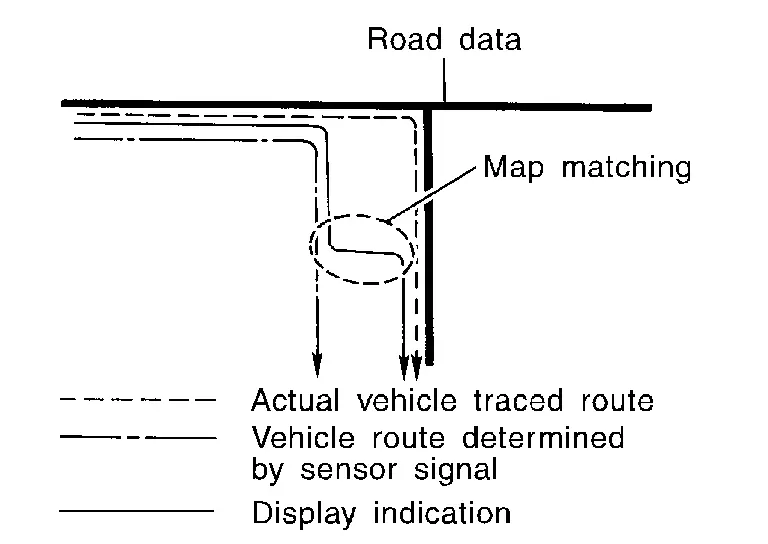
The vehicle position may not be corrected under the following circumstances and after driving for a certain time when GPS information is difficult to receive. In this case, the Nissan Pathfinder vehicle mark on the display must be corrected manually:
-
In map-matching, alternative routes to reach the destination will be shown and prioritized, after the road on which the Nissan Pathfinder vehicle is currently driving has been judged and the vehicle mark has been repositioned.
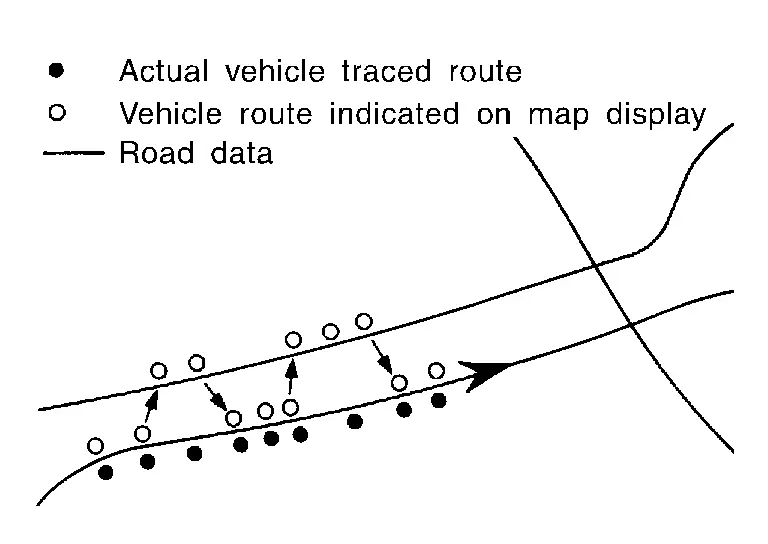
Alternative routes will be shown in different order of priority, and the incorrect road can be avoided if there is an error in distance and/or direction.
Routes are of the same priority if two roads are running in parallel. Therefore, the Nissan Pathfinder vehicle mark may appear on either of them alternately, depending on maneuvering of the steering wheel and configuration of the road.
-
Map-matching does not function correctly when a road on which the Nissan Pathfinder vehicle is driving is new and not recorded in the map data, or when road pattern stored in the map data and the actual road pattern are different due to repair.

The map-matching function may find another road and position the Nissan Pathfinder vehicle mark on it when driving on a road not present in the map. Then, the vehicle mark may change to it when the correct road is detected.
-
Effective range for comparing the Nissan Pathfinder vehicle position and travel direction calculated by the distance and direction with the road data read from the map data is limited. Therefore, correction by map-matching is not possible when there is an excessive gap between current Nissan Pathfinder vehicle position and the position on the map.
GPS (Global Positioning System)
GPS (Global Positioning System) is developed for and is controlled by the US Department of Defense. The system utilizes GPS satellites (NAVSTAR), transmitting out radio waves while flying on an orbit around the earth at an altitude of approximately 21,000 km (13,049 mile).
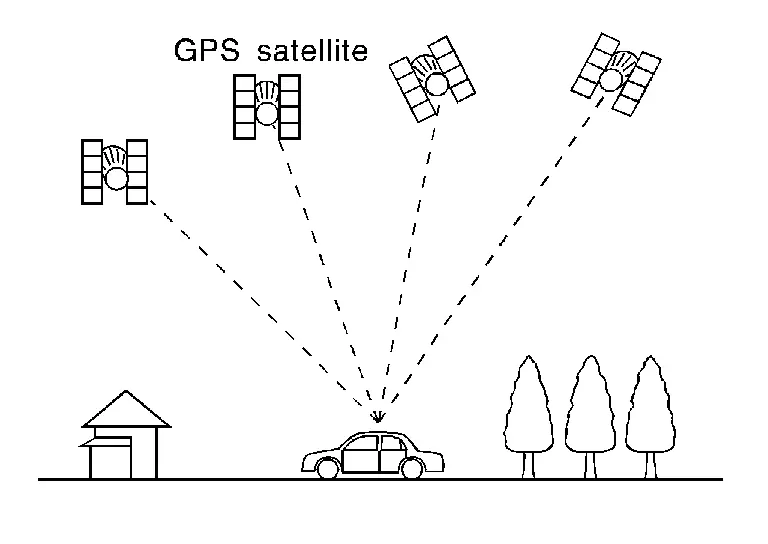
The receiver calculates the travel position in three dimensions (latitude/longitude/altitude) according to the time lag of the radio waves that four or more GPS satellites transmit (three-dimensional positioning). The GPS receiver calculates the travel position in two dimensions (latitude/longitude) with the previous altitude data if the GPS receiver receives only three radio waves (two-dimensional positioning). GPS position correction is not performed while stopping the Nissan Pathfinder vehicle.
Accuracy of the GPS will deteriorate under the following conditions:
-
In two-dimensional positioning, GPS accuracy will deteriorate when altitude of the vehicle position changes.
-
The position of GPS satellite affects GPS detection precision. The position detection may not be precisely performed.
-
The position detection is not performed if GPS receiver does not receive radio waves from GPS satellites. (Inside a tunnel, parking in a building, under an elevated highway etc.) GPS receiver may not receive radio waves from GPS satellites if any object is placed on the GPS antenna.
 NOTE:
NOTE:
-
The detection result has an error of approximately 10 m (32.81 ft) even with a high-precision three dimensional positioning.
-
There may be cases when the accuracy is lowered and radio waves are stopped intentionally because the GPS satellite signal is controlled by the US trace control center.
HANDS-FREE PHONE SYSTEM
System Operation
 NOTE:
NOTE:
Cellular telephones must have their wireless connection set up (paired) before using the Bluetooth® telephone system.
The Bluetooth® telephone system allows users who have a Bluetooth® cellular telephone to make a wireless connection between their cellular telephone and the AV control unit. Hands-free cellular telephone calls can be sent and received. Some Bluetooth® cellular telephones may not be recognized by the AV control unit. When a cellular telephone or the AV control unit is replaced, the telephone must be paired with the AV control unit. Different cellular telephones may have different pairing procedures, refer to the cellular telephone operating manual.
Refer to the Owner's Manual for Bluetooth® telephone system operating instructions.
AV Control Unit
When the ignition switch is turned ON, the AV control unit will power up. During power up, the AV control unit is initialized and performs various self-checks. Initialization may take up to 20 seconds.
Steering Switches
When buttons on the steering switches are pushed, the resistance in steering switch circuits change, depending on which button is pushed.
The following functions can be performed using the steering switches:
-
Initiate self-diagnosis of the Bluetooth® telephone system
-
Start a voice recognition session
-
Answer and end telephone calls
-
Adjust the volume of calls
-
Record memos
Microphone
-
The microphone is located in the roof in the map lamp assembly.
-
For vehicles without Bose audio system, the microphone sends a signal to the AV control unit.
-
For Nissan Pathfinder vehicles with Bose audio system, the microphone sends a signal to the TCU, the TCU sends the signal to the AV control unit.
SATELLITE RADIO FUNCTION
-
Satellite radio function is built into AV control unit.
-
Sound signal (satellite radio) is received by antenna base (satellite antenna) and transmitted to AV control unit. AV control unit outputs sound signal to each speaker.
FRONT AUXILIARY INPUT JACKS FUNCTION
-
For vehicles without Bose audio system, sound and data signals are transmitted from USB interfaces to the AV control unit and output to each speaker.
-
For Nissan Pathfinder vehicles with Bose audio system, sound and data signals are transmitted from USB interfaces to the AV control unit. The AV control unit sends the audio signals to the Bose speaker amp. The Bose speaker amp. then sends the audio signals to each speaker.
SPEED SENSITIVE VOLUME SYSTEM
-
Volume level of this system goes up and down automatically in proportion to the vehicle speed.
-
The control level can be selected by the customer.

Nissan Pathfinder (R53) 2022-2025 Service Manual
Contact Us
Nissan Pathfinder Info Center
Email: info@nipathfinder.com
Phone: +1 (800) 123-4567
Address: 123 Pathfinder Blvd, Nashville, TN 37214, USA
Working Hours: Mon–Fri, 9:00 AM – 5:00 PM (EST)
